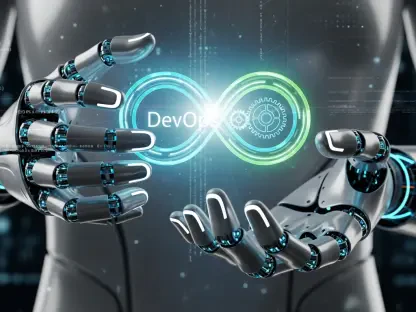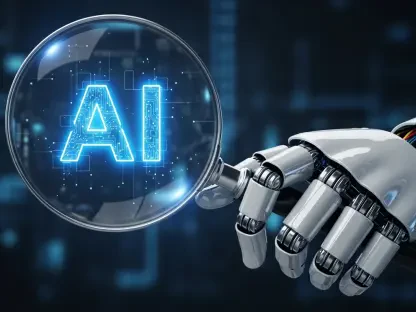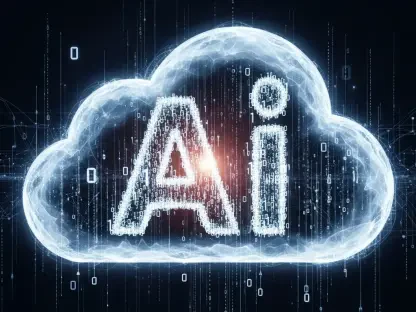In the fast-evolving world of software development, imagine a scenario where entire projects are completed not by a team of human coders, but by a virtual ensemble of AI agents working seamlessly in the cloud. This is no longer a distant vision but a reality with the emergence of cutting-edge tools that are reshaping how code is written, tested, and deployed. The industry stands at a pivotal moment, witnessing a shift from traditional, manual coding environments to AI-driven platforms that promise unprecedented efficiency and automation. Amid this transformation, a new player has entered the scene, setting a benchmark for innovation and addressing long-standing challenges in safety and collaboration.
The Landscape of AI-Driven Software Development
The software development sector is undergoing a profound change, driven by the integration of artificial intelligence into coding tools. Traditional environments, once reliant on individual developers using isolated editors, are giving way to AI-powered solutions that assist with code generation, debugging, and even project management. This transition reflects a broader push for efficiency as developers seek to reduce repetitive tasks and focus on creative problem-solving. Major advancements in machine learning algorithms and natural language processing have fueled this shift, enabling tools to understand complex instructions and produce functional code with minimal human input.
A key aspect of this evolution is the segmentation of AI tools into distinct categories. Single-agent assistants, which provide basic coding support, are now being supplemented by emerging multi-agent systems that simulate team dynamics for comprehensive project handling. Cloud-based platforms, offering scalability and remote collaboration, are gaining traction as a preferred choice for modern development needs. Influential technologies such as cloud computing enable seamless resource allocation, while market leaders like Replit, Cursor, and Augment continue to innovate alongside fresh entrants like AiYouthLab, each vying to redefine the developer experience.
Safety and reliability remain critical concerns shaping the direction of this industry. High-profile incidents, such as unintended data losses caused by AI tools, have highlighted the risks of unchecked automation. These challenges underscore the need for robust safeguards and have prompted developers and companies to prioritize secure environments in their adoption of AI solutions. As the market evolves, balancing innovation with accountability will be essential to sustaining trust and driving further growth in AI-driven development tools.
Innovations and Trends in AI Programming Tools
Key Trends Shaping the Future
The trajectory of AI programming tools is marked by a notable shift from solitary AI assistants to collaborative multi-agent systems. These advanced setups, exemplified by pioneering solutions, distribute tasks among specialized agents, mimicking the structure of human development teams. Such systems are designed to handle intricate projects by dividing responsibilities, thereby enhancing productivity and reducing the burden on individual developers. This trend signals a future where AI can replicate complex team interactions, fundamentally altering the coding process.
Cloud environments are increasingly becoming the backbone of these innovations due to their ability to provide scalability, security, and resource efficiency. By hosting AI agents in a centralized, flexible space, developers can access powerful computing capabilities without the limitations of local hardware. This migration also facilitates standardized execution, minimizing errors caused by inconsistent setups. The growing reliance on cloud platforms reflects a broader industry consensus on their value in supporting large-scale, collaborative development efforts.
Emerging technologies further propel this transformation, with dynamic task planning allowing AI to adapt to changing project requirements in real time. Long-context engineering ensures that tools maintain coherence over extended interactions, addressing previous limitations in memory and understanding. Additionally, evolving developer needs are pushing for greater automation, minimizing manual oversight in project-level tasks. These advancements open new opportunities for AI to emulate human team dynamics, paving the way for more intuitive and efficient development workflows.
Market Insights and Growth Projections
Data indicates a rapid rise in the adoption of AI programming tools, particularly those hosted in the cloud. Industry reports suggest that cloud-based solutions are capturing a significant share of the market, driven by their ability to handle complex, multi-agent collaborations. This surge is attributed to the demand for tools that can streamline entire development cycles, from ideation to deployment, without requiring extensive human intervention. The efficiency gains are substantial, with claims of performance being dozens of times faster than traditional methods.
Looking ahead, growth forecasts for multi-agent integrated development environments (IDEs) are highly optimistic, projecting significant expansion over the next five to ten years. Analysts anticipate that these systems will dominate the market as businesses seek to leverage automation for competitive advantage. Investment in this sector is expected to grow, fueled by the promise of reduced development timelines and enhanced project outcomes. The integration of safety features and error mitigation strategies will likely play a crucial role in sustaining this upward trajectory.
From a forward-looking perspective, the emphasis on automation is poised to attract further capital and drive widespread adoption. Performance indicators highlight not only speed but also improvements in code quality and reliability, encouraging stakeholders to explore these tools for diverse applications. As the industry matures, the focus on creating developer-friendly interfaces alongside robust backend systems will be key to unlocking the full potential of AI in programming, ensuring long-term growth and innovation.
Challenges in AI-Driven Development Environments
The integration of AI into development environments, while promising, is not without significant hurdles. Safety risks stand out as a primary concern, underscored by past incidents where AI tools inadvertently caused critical errors, such as database deletions experienced by platforms like Replit. These events have exposed vulnerabilities in unchecked AI operations, raising questions about the readiness of such systems for widespread use. Addressing these risks requires a concerted effort to build fail-safes that prevent catastrophic outcomes during development processes.
Technological challenges also loom large, particularly in maintaining context over long development cycles. AI agents often struggle to retain a comprehensive understanding of project history, leading to inefficiencies and errors in complex tasks. Managing interactions among multiple agents adds another layer of difficulty, as miscommunications or conflicting actions can derail progress. These issues necessitate advanced algorithms and architectures capable of sustaining coherence and coordination across extended workflows, a challenge that remains a focal point for developers of AI tools.
Market-driven issues further complicate the landscape, with user trust being a critical barrier to adoption. Developers remain wary of relying on AI for mission-critical tasks, especially in light of past mishaps, emphasizing the need for robust error-handling mechanisms. Solutions like isolated cloud environments, which limit the impact of potential errors, and sophisticated debugging tools are emerging as viable strategies. These approaches aim to rebuild confidence by ensuring that AI actions are both predictable and contained, fostering a safer development ecosystem for all stakeholders.
Regulatory and Safety Considerations in AI Programming
Navigating the regulatory landscape is a vital aspect of deploying AI programming tools, particularly in cloud-based setups where data protection and system security are paramount. Governments and industry bodies are increasingly establishing standards to govern the use of AI, focusing on safeguarding user information and ensuring operational integrity. Compliance with these regulations is not merely a legal obligation but a cornerstone of building trust among developers and businesses adopting these technologies.
The role of compliance extends to ensuring safe AI operations, especially as cloud environments handle sensitive project data across multiple jurisdictions. High-profile incidents, such as the database mishap involving Replit, have intensified calls for stricter guidelines and safety protocols. These events have catalyzed discussions on the necessity of clear boundaries for AI actions, prompting tool developers to integrate protective measures that align with regulatory expectations. Such steps are essential to prevent systemic failures and maintain industry credibility.
Innovative responses to these demands include sandbox isolation and secure cloud configurations, which limit the scope of AI activities to controlled spaces. These mechanisms address both regulatory requirements and safety concerns by preventing unauthorized access to critical systems. However, the broader impact of regulations on innovation cannot be overlooked, as overly stringent rules may stifle experimentation and slow adoption rates. Striking a balance between oversight and flexibility will be crucial to fostering growth while protecting the interests of all parties involved in AI-driven development.
Future Directions for AI in Software Development
The potential evolution of AI tools points toward fully autonomous development teams capable of handling projects with minimal human oversight. This vision entails AI agents not only coding but also strategizing, testing, and deploying solutions independently, effectively mirroring the capabilities of human teams. Such a shift could revolutionize the industry by drastically cutting development costs and timelines, allowing businesses to focus on innovation rather than execution.
Emerging disruptors, including advanced multi-agent systems and visual perception tools like WebView, are set to redefine the boundaries of what AI can achieve in coding. These technologies enable agents to interpret dynamic changes and simulate user interactions, enhancing debugging and usability testing. Meanwhile, changing consumer preferences among developers favor automation and seamless integration between local and cloud environments, pushing vendors to prioritize user-friendly, hybrid solutions that cater to diverse workflows.
Growth areas such as project-level automation and cross-terminal collaboration are expected to shape the industry’s future. These domains promise to address the complexities of modern software projects by enabling AI to manage interdependencies and streamline processes across distributed systems. Influencing factors, including global tech investments and advancements in AI models, will further accelerate progress, though economic conditions may introduce variability. Collectively, these elements suggest a dynamic path ahead, with AI poised to become an indispensable partner in software creation.
Conclusion and Industry Outlook
Reflecting on the insights gathered, it becomes evident that the introduction of a pioneering cloud-based AI team IDE marks a transformative moment for software development. Its role in enhancing safety, driving efficiency, and pushing the boundaries of automation stands out as a significant contribution to the field. The emphasis on multi-agent systems and cloud adoption underscores a shift that redefines how projects are conceptualized and executed.
Looking back, the discussions on challenges and regulatory considerations highlight the importance of balancing innovation with accountability. Stakeholders are encouraged to take actionable steps by investing in secure, scalable AI solutions that prioritize developer needs. Exploring partnerships and funding for research into advanced safety mechanisms emerges as a critical next step to ensure sustainable growth.
Ultimately, the journey of AI in coding reveals a landscape ripe with opportunity, where tools that foster human-machine collaboration gain prominence. Industry players are urged to focus on creating adaptable, user-centric platforms while anticipating future disruptions through continuous innovation. This approach promises to solidify AI’s place as a cornerstone of software development, setting the stage for groundbreaking advancements in the years to come.









